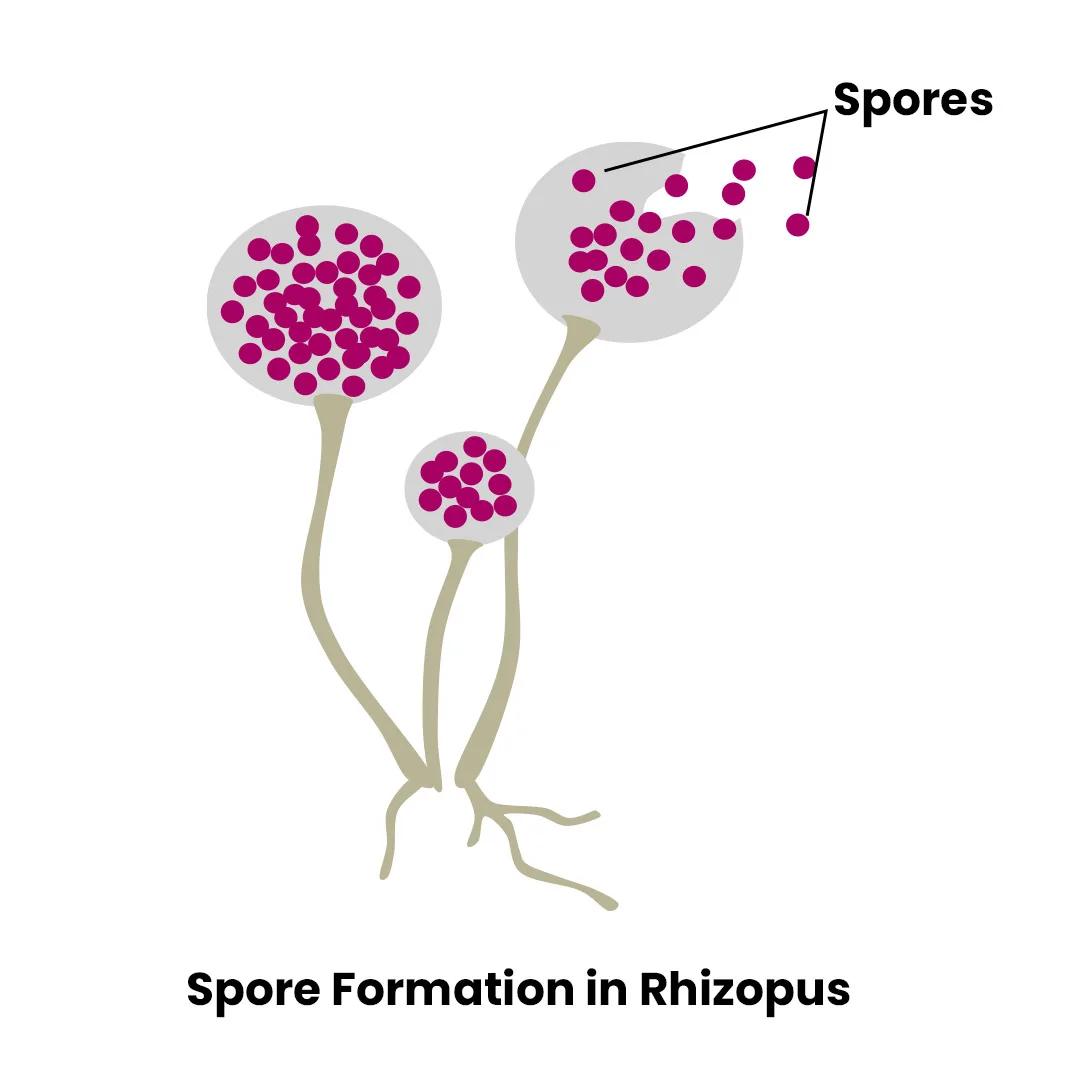
Rhizopus: Rhizopus is a fungal genus known for its saprophytic and parasitic nature. These fungi, which prefer damp or moist conditions, are commonly found in organic matter such as fruits, vegetables, bread, and jellies. Rhizopus' vegetative structure is defined by coenocytic (multinucleated) and branched hyphae.
Rhizopus species are used to produce a variety of chemicals and alcoholic beverages. Certain species, however, can be harmful, causing plant diseases and possibly infecting humans with mucormycosis. This article provides NEET aspirants with information on Rhizopus, including its diagram, hyphae structure, classification, characteristics, reproductive methods, microscopic appearance, examples, and economic significance.Pre Fertilisation: Structures and Events
What is Rhizopus?
Rhizopus is a genus of filamentous fungi comprising around 10 species found in the family Rhizopodaceae (formerly Mucoraceae), within the order Mucorales. While some species, like Rhizopus stolonifer (bread mold), are industrially important, others cause diseases in plants and animals. They are commonly found in various organic materials and play a role in nutrient cycling. Rhizopus fungi are diverse organisms with industrial, pathogenic, and ecological significance. Their ability to decompose organic matter contributes to nutrient cycling, but some species can also cause diseases in plants and animals. Understanding the characteristics and uses of Rhizopus species is essential for various industries and agricultural practices.Rhizopus Diagram
The rhizopus diagram is as follows:
Rhizopus Under Microscope
Rhizopus microscope view shows a network of aseptate hyphae that branch extensively, giving the organism a fuzzy appearance. Rhizopus' key microscopic structures are hyphae, sporangiophores, sporangia, and sporangiospores. These structures differ in color and size depending on the Rhizopus species. Microscopic examination sheds light on Rhizopus' morphology, reproduction, and potential roles in food spoilage or disease.Rhizopus Classification
Rhizopus, a genus within the phylum Zygomycota, is characterised by the production of zygospores during sexual reproduction. Commonly known as black bread mould or pin mould, Rhizopus is classified as follows:| Rhizopus Classification | |
|---|---|
| Category | Classification |
| Rhizopus Domain | Eukaryota |
| Rhizopus Kingdom | Fungi |
| Rhizopus Phylum | Zygomycota |
| Rhizopus Class | Zygomycetes |
| Rhizopus Order | Mucorales |
| Rhizopus Family | Mucoraceae |
| Rhizopus Genus | Rhizopus |
Rhizopus Species
Rhizopus is a genus comprising approximately 10 fungal species. Several notable species of Rhizopus include:- Rhizopus stolonifer (black bread mold): This species is the most prevalent within the genus and acts as a saprophyte, decomposing dead organic matter. It is also employed in industry to produce fumaric acid, a compound used in food and pharmaceuticals.
- Rhizopus oryzae (synonym: Rhizopus arrhizus ): Used in the production of tempeh, a fermented soybean cake popular in Indonesia, Rhizopus oryzae can also lead to mucormycosis, a severe fungal infection.
- Rhizopus microsporus: Commonly associated with mucormycosis, this species is also utilised in industry to manufacture cortisone, a type of steroid medication.
- Rhizopus delemar: This species is involved in the production of fumaric acid and biotin, a vitamin.
Rhizopus Characteristics
Rhizopus, a genus of filamentous fungi commonly known as bread molds, exhibits rapid growth and asexual reproduction through spore production. Key characteristics include:- Morphology: Rhizopus species display a cottony or woolly appearance due to their mycelium, composed of branching hyphae.
- Habitat: Found on decaying organic matter like bread, fruits, vegetables, and soil.
- Reproduction : Asexual reproduction via sporangia formation, which releases sporangiospores for dispersal and germination.
- Rhizoids: Root-like structures anchoring the fungus and aiding in nutrient absorption.
- Sexual reproduction: Under specific conditions, sexual reproduction occurs, forming zygospores from fused gametangia.
- Economic importance: Some species are crucial in food production (e.g., tempeh fermentation), while others can be pathogenic to plants, animals, and humans.
- Optimal growth conditions: Thrive in warm, humid environments with temperatures between 20-30°C.
- Spore dispersal: Sporangiospores disperse through air currents, water, or physical contact, facilitating colonization of new substrates.
Sexual Reproduction in Flowering Plants
Rhizopus Structure
Rhizopus fungi are characterised by their rapid growth and cottony appearance. The body of Rhizopus comprises branched mycelium, which is coenocytic. The mycelium consists of three types of hyphae:- Stolon: Aerial and arching, stolon is present in the internodal region, touching the substratum to form nodal regions.
- Rhizoids: Branching structures that anchor the mycelium to the substratum and absorb food, forming where stolons touch the substratum at nodes.
- Sporangiophores: Vertical, unbranched hyphae that grow from stolons and produce a reproductive structure called sporangiospores.
- Cell Wall: Composed of chitin, chitosan, lipids, and proteins.
- Protoplasm: Contains nuclei, mitochondria, endoplasmic reticulum, and various cytoplasmic inclusions like ribosomes and oil droplets.
- Columella: A hygroscopic structure arising from u-shaped sporangiophores, primarily responsible for water absorption.
- Sporangium: A spherical or globose structure that connects the columella and sporangiophore, containing sporangiospores.
- Sporangiospores: Unicellular asexual spores.
| Other NEET Biology Topics | ||
|---|---|---|
| Ribosomes | Pollination | Apomixis |
| Centrosome | Embryo | Tissues |
Rhizopus Reproduction
Rhizopus undergoes three modes of reproduction: vegetative, asexual, and sexual.- Vegetative Reproduction:
- Occurs through fragmentation.
- Each stolon fragment develops independently, forming a complete mycelium.
- Asexual Reproduction:
- Terminal formation in sporangia of aerial mycelium (sporangiophores).
- Sporangiophores develop from the upper side of the rhizoidal node.
- Apical swelling forms sporangium, with nuclei and cytoplasm moving apically.
- Differentiation of sporangium cytoplasm into the denser peripheral region with more nuclei and central columella region with fewer nuclei and more vacuoles.
- Sporangiospores develop inside sporangium, being multinucleated and non-motile.
- The sporangium wall ruptures after maturation, releasing sporangiospores as powdery masses.
- Each spore germinates into new mycelium under suitable conditions.
- Formed during unfavorable conditions.
- An intercalary segment of mycelium develops due to septae formation and protoplasm accumulation.
- Thick-walled chlamydospore detaches from mycelium once it dries.
- Chlamydospores remain dormant until favourable conditions return, then germinate to form new mycelium.
- Sexual Reproduction:
- Involves the fusion of two compatible hyphae.
- Most Rhizopus species (e.g., R. stolonifera) are heterothallic, having different mycelia for + and - mating strains, while R. sexualis is homothallic.
- Compatible hyphae develop small outgrowths known as progametangia in both mycelia.
- Nuclei and cytoplasm move towards the apical region, and progametangia make contact.
- The apical region is separated from the rest of the hyphae by septae formation, forming gametangia.
- Gametangia conjugate to form a multinucleated structure.
- Plasmogamy is followed by karyogamy, forming a diploid (2n) zygote known as a zygospore, with the rest of the unpaired nuclei degenerating.
- Zygospores enlarge, becoming thick-walled and resistant to adverse environmental conditions. Upon receiving favourable conditions, zygospores germinate.
- The inner wall of the zygospore develops into promycelium, forming germ sporangiophore, with germ sporangium formed apically.
- Meiosis occurs, forming haploid meiospores, which come out after the rupture of the germ sporangium wall, developing into new mycelia.
Rhizopus Hyphae
Rhizopus, a common mould found on decaying fruits, possesses specialised filaments called hyphae. These hyphae have unique characteristics:- Coenocytic and Branching: Rhizopus hyphae lack internal walls, making them coenocytic. They also branch out, forming a mycelium.
- Three Types of Hyphae:
- Stolons: Aerial hyphae acting as runners, extending outward and curving upwards.
- Rhizoids: Root-like structures produced by stolons, anchoring the fungus and absorbing nutrients.
- Sporangiophores: Upright, unbranched hyphae that produce sporangia at their tips for reproduction.
Rhizopus Economic Importance
Rhizopus, a genus of filamentous fungi known as bread molds, holds considerable economic importance despite being often viewed as a food spoilage agent. Here are its key roles:- Food Fermentation: Rhizopus species, notably Rhizopus oligosporus, are crucial in fermenting foods like tempeh. This Indonesian delicacy is made from fermented soybeans, enhancing their nutritional value and flavour.
- Enzyme Production: Rhizopus species produce enzymes like amylases and lipases. These enzymes find application in various industries, such as starch breakdown in food and lipid degradation in detergents.
- Organic Acid Synthesis: Certain Rhizopus species produce organic acids like citric acid, widely used in the food and beverage industry as an acidulant, flavouring agent, and preservative.
- Biological Control: Some Rhizopus species act as biological control agents against plant pathogens, inhibiting the growth of harmful fungi and protecting crops.
- Bioremediation: Rhizopus species are studied for their ability to degrade pollutants like pesticides and hydrocarbons, making them valuable in cleaning up contaminated environments.
- Research: Rhizopus serves as a model organism in genetics and molecular biology research due to its rapid growth and ease of cultivation, aiding in the study of various biological processes.
| NEET Exam Important Links | |
|---|---|
| NEET Syllabus | NEET Biology Diagrams |
| NEET Biology MCQ | NEET Biology Chapter wise Weightage |
| NEET Biology Notes | NEET Previous Year Question papers |
Rhizopus FAQs
Why is Rhizopus called black mould?
Rhizopus stolonifer is commonly known as bread mould because it is a black mould that grows on bread. It thrives when bread is exposed to air, allowing its spores to float around. If mould appears on bread, it is considered spoiled.
Does Rhizopus cause disease?
Rhinocerebral mucormycosis is a rare fungal infection primarily reported in the United States of America and Europe. It is caused by zygomycete fungi, most commonly by a species of Rhizopus.
What is Rhizopus also known as?
Rhizopus shares the common name "bread mold" with the entire phylum Zygomycota, in which it is classified.
Who named Rhizopus?
Rhizopus oryzae was discovered by Frits Went and Hendrik Coenraad Prinsen Geerligs in 1895. The genus Rhizopus was established in 1821 by the German mycologist Christian Gottfried Ehrenberg to distinguish Mucor stolonifer and Rhizopus nigricans from the genus Mucor.
Is Rhizopus stolonifer white or black?
Rhizopus stolonifer, often known as black bread mold, is actually the most common type of mould worldwide. However, it is more likely to appear green, grey, or even white.
Is Rhizopus aerobic or anaerobic?
Rhizopus cultures from starters demonstrate both microaerophilic and aerobic growth. The ability to grow in low oxygen conditions and the subsurface growth of mycelia in tubes suggest a potential for exploiting microaerophile-like characteristics in certain starter molds.
Talk to a counsellorHave doubts? Our support team will be happy to assist you!

Check out these Related Articles
Free Learning Resources
PW Books
Notes (Class 10-12)
PW Study Materials
Notes (Class 6-9)
Ncert Solutions
Govt Exams
Class 6th to 12th Online Courses
Govt Job Exams Courses
UPSC Coaching
Defence Exam Coaching
Gate Exam Coaching
Other Exams
Know about Physics Wallah
Physics Wallah is an Indian edtech platform that provides accessible & comprehensive learning experiences to students from Class 6th to postgraduate level. We also provide extensive NCERT solutions, sample paper, NEET, JEE Mains, BITSAT previous year papers & more such resources to students. Physics Wallah also caters to over 3.5 million registered students and over 78 lakh+ Youtube subscribers with 4.8 rating on its app.
We Stand Out because
We provide students with intensive courses with India’s qualified & experienced faculties & mentors. PW strives to make the learning experience comprehensive and accessible for students of all sections of society. We believe in empowering every single student who couldn't dream of a good career in engineering and medical field earlier.
Our Key Focus Areas
Physics Wallah's main focus is to make the learning experience as economical as possible for all students. With our affordable courses like Lakshya, Udaan and Arjuna and many others, we have been able to provide a platform for lakhs of aspirants. From providing Chemistry, Maths, Physics formula to giving e-books of eminent authors like RD Sharma, RS Aggarwal and Lakhmir Singh, PW focuses on every single student's need for preparation.
What Makes Us Different
Physics Wallah strives to develop a comprehensive pedagogical structure for students, where they get a state-of-the-art learning experience with study material and resources. Apart from catering students preparing for JEE Mains and NEET, PW also provides study material for each state board like Uttar Pradesh, Bihar, and others
Copyright © 2025 Physicswallah Limited All rights reserved.
Get App









